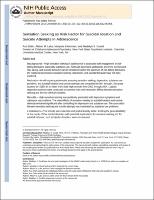Please use this identifier to cite or link to this item:
https://hdl.handle.net/20.500.12202/9635Full metadata record
| DC Field | Value | Language |
|---|---|---|
| dc.contributor.author | Ortin, Ana | - |
| dc.contributor.author | Lake, Alison M. | - |
| dc.contributor.author | Kleinman, Marjorie | - |
| dc.contributor.author | Gould, Madelyn S. | - |
| dc.date.accessioned | 2023-12-13T16:22:23Z | - |
| dc.date.available | 2023-12-13T16:22:23Z | - |
| dc.date.issued | 2012 | - |
| dc.identifier.citation | Ortin, A., Lake, A. M., Kleinman, M., & Gould, M. S. (2012). Sensation seeking as risk factor for suicidal ideation and suicide attempts in adolescence. Journal of Affective Disorders, 143(1–3), 214–222. https://doi.org/10.1016/j.jad.2012.05.058 | en_US |
| dc.identifier.issn | 0165-0327 | - |
| dc.identifier.uri | https://hdl.handle.net/20.500.12202/9635 | - |
| dc.description | Scholarly article / Open access | en_US |
| dc.description.abstract | Abstract Background—High sensation seeking in adolescence is associated with engagement in risktaking behaviors, especially substance use. Although depressed adolescents are prone to increased risk-taking, and suicidal behavior can be considered within the spectrum of risk-taking behaviors, the relationships between sensation seeking, depression, and suicidal behavior have not been explored. Methods—A self-report questionnaire assessing sensation seeking, depression, substance use problems, and suicidal ideation and suicide attempts was completed by 9th- through 12th-grade students (n=2189) in six New York State high-schools from 2002 through 2004. Logistic regression analyses were conducted to examine main and interaction effects between sensation seeking and the four clinical variables. Results—High sensation seeking was positively associated with depressive symptoms and substance use problems. The main effects of sensation seeking on suicidal ideation and suicide attempts remained significant after controlling for depression and substance use. The association between sensation seeking and suicide attempts was moderated by substance use problems. Limitations—The schools were suburban and predominantly white, limiting the generalizability of the results. Other mental disorders with potential implications for sensation seeking and for suicidal behavior, such as bipolar disorders, were not assessed. | en_US |
| dc.description.sponsorship | __Acknowledgments __Role of funding source _This research was supported by National Institute of Mental Health (NIMH) grant R01 MH64632. In addition, the first author received support from a research grant from Alicia Koplowitz Foundation (Spain). _The sponsors were not involved in the design and conduct of the study; collection, management, analysis, and interpretation of the data; or in the preparation, review, or approval of the manuscript. | en_US |
| dc.language.iso | en_US | en_US |
| dc.publisher | Elsevier B.V. | en_US |
| dc.relation.ispartofseries | Journal of Affective Disorders;143(1-3) | - |
| dc.rights | Attribution-NonCommercial-NoDerivs 3.0 United States | * |
| dc.rights.uri | http://creativecommons.org/licenses/by-nc-nd/3.0/us/ | * |
| dc.subject | Sensation seeking | en_US |
| dc.subject | Adolescence | en_US |
| dc.subject | Suicidal ideation | en_US |
| dc.subject | Suicide attempts | en_US |
| dc.subject | Depression | en_US |
| dc.subject | Substance use | en_US |
| dc.title | Sensation seeking as risk factor for suicidal ideation and suicide attempts in adolescence. | en_US |
| dc.type | Article | en_US |
| dc.identifier.doi | https://doi.org/10.1016/j.jad.2012.05.058 | en_US |
| dc.contributor.orcid | 0000-0003-0825-6003 | en_US |
| local.yu.facultypage | https://www.einsteinmed.edu/faculty/17519/ana-ortin-peralta/ | en_US |
| Appears in Collections: | Ferkauf Graduate School of Psychology: Faculty Publications | |
Files in This Item:
| File | Description | Size | Format | |
|---|---|---|---|---|
| Ortin 2012 OA Sensation seeking nihms384998.pdf | 301.87 kB | Adobe PDF |  View/Open |
This item is licensed under a Creative Commons License

